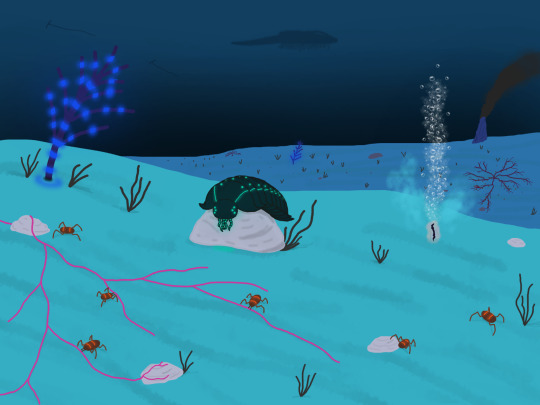#Thai'qul
Text
Medusa-Class Battleship

Creator: Thai'Qul
Length: 798 Meters
Width: 378 Meters (Widest Point); 70 meters (Narrowest Point)
Propulsion: Nuclear Pulse Drive; Five Fusion Drive Thrusters
Crew Complement: 5,000-7,000 (Normal complement); 10,000 (Max. Capacity)
Radiator Type: Solid-State/Droplet
Armaments:
x8 40mm Point Defense Cannons (PDCs) (Aft)
x4 Cargo/Torpedo Bays (Aft)
x2000 5-kiloton driver warheads (Aft)
x4 Ultra-Relativistic Electron Beam (UREB) Cannons (Bow)
Interior
Because the Thai'Qul are an aquatic species, their ships are unique in being almost entirely filled with water. This pulls triple duty in protecting the occupants from intense G-forces, radiation and heat; providing resources for the fusion reactor and torpedoes, and in the event of a hull breach, lost water can be more easily retrieved than air. The consequence of this is that it increases the ship's overall mass, requiring more energy for any kind of acceleration or deceleration. This is also another reason for their ruthless pragmatism: the lack of air pockets outside the cargo sections prevents them from easily taking prisoners or taking larger ships aboard.
Creators
An average Thai'Qul male. Roughly 85% of the species is male, carrying out tasks for the rarely-seen matriarchs, who outsize them significantly. On ships such as the Medusa-class, prepubescent matriarchs- referred to colloquially as "Countesses"- serve the role of captains and admirals.
Strategic Overview
If there's any way to describe the Thai'Qul military doctrine, it would be ruthless pragmatism. Rather than engaging in widespread power projection, heavier ships are mostly concentrated within their own systems, while smaller vessels are the most commonly encountered. These represent the first line of defense, focused on patrolling defense perimeters.
Should a perimeter be broken and an enemy force infiltrate a Thai'Qul system, either by evading or destroying lighter vessels, this is when battleships such as the Medusa-class are deployed. This typically follows barrages of Thai'Qul frigates and corvettes, which will try to guide invaders into designated kill zones, where the Medusa-class will engage them at close range, such as near large asteroids, space stations or ring systems.
While these battleships lack high speed or fine maneuvering, they make up for it with powerful defenses and overwhelming firepower, particularly their UREBs. Once the invader's shields and other defenses have been exhausted, should they refuse to surrender, attacks from these beams will irradiate and effectively sterilize the target.
This is done because, rather than simply blowing up bellicose ships, the Thai'Qul will always try to salvage as much technology and information from them as possible, either to assess motivations or reverse-engineer whatever they discover. Of course, should a ship surrender instead, the Thai'Qul will gladly accept, taking the time to analyze captured ships just as thoroughly.
This doctrine has proven to be quite effective in multiple engagements and ensured invasions of their systems are rare.
Ship Diagram
The Bow Shield is a large dome entirely covered in ablative heat-resistant armor.
The nose of the craft houses the four UREB cannons, which cover a large hemispherical field. While the beams lose effectiveness over time or when fired at an angle, time dilation effects prevent them from completely dissipating over longer ranges. Maximum energy from the bremsstrahlung resulting from impact has been measured at over 5,000 Sieverts.
The UREBs are only possible via the battleship's length, where the linear accelerator (Linac) runs along the central axis of the ship.
The Medusa-Class doesn't have a designated bridge or command module, but instead 36 large windowless spheres, where most of the crew resides. Commands, controls and sensor readings are instead performed using holographic display interfaces that crew members can pull up at any moment. This ensures damage to one area of the ship will not compromise control, and that key staff can be moved into the interior.
The ship uses a combination of solid-state and droplet cooling with liquid lithium, firing the molten coolant into space, where it condenses into larger drops before being recaptured in a dish section for recirculation. Additional radiators vent excess heat to prevent the lithium from completely vaporizing. In times of duress, this coolant can be used as everything from makeshift flares to additional thrusters.
The aft section consists of a large octagonal cylinder, which houses bay sections designed to be drained of water so cargo, torpedoes and other craft can be sent into space. This is also where the ship's fusion reactor is housed.
The PDCs, nicknamed "Barnacles," allow the ship to fire at targets behind or beside the ship.
Contrary to popular belief, the piston supports are only painted blue and not transparent, though they are full of water to help cushion the impact following a pulse.
The pistons and their shock absorbers are attached to a set of electric motors, which extract a small, but not insubstantial amount of power from every pulse.
The Drive Cone is fitted with flexible rings and is even colored bright white to take advantage of as much radiation pressure as possible. Usage of this drive is why the battleship can't be used in a planetary orbit, as the risk of creating radiation belts poses a threat to orbital infrastructure.
#the-helixverse#ekpyrosis#thai'qul#spaceship#worldbuilding#my art#hard science fiction#hard sci fi#ship design#project orion#worldbuilding art#scifi art
22 notes
·
View notes
Note
is it me or does that ship/cannon/whatever it is have a lot of balls?
//Yep! And there's a good reason for that
//I explain it in detail here ^^
3 notes
·
View notes
Note
This may be a stupid question but how do the Thai'Qul operate electronics without them being y’know shocked with extremely high voltage due to how conductive water is?
Quite simple, really: Fiber Optics!

While we primarily use conductive metals like copper for our wires, fiber optics- being essentially transparent tubes of glass- are the primarily means of transporting internet signals across the world. In fact, most of them are in the ocean.

Like other wires, conductivity and signal integrity are place thanks to layers of multiple material, mostly plastics, and they can get signals across the entire planet in seconds.
Fiber optics have only been around on Earth for about 80 years, but the Thai'Qul have had them much longer, although it took time before they were able to make use of them in the same way we did. While they didn't discover fire, they were able to forge materials through a combination of deep sea vents, natural fission reactors and intense pressure allowing new materials to be forged.
The short answer is that their tech is mostly fiber optic-based, and with no current directly exposed to water, there's no risk of electrocution.
It's the one design advantage when your planet is completely covered in oceans : P
1 note
·
View note
Note
Seeing the Thai’Quail being a sapient race despite being ocean dwellers makes me wonder if a civilisation could develop on rogue planets. After all, if they have Europa-like oceans they may never see the surface and the ice would protect the planet from any kind of cosmic extinction event such as Asteroids or Gamma bursts.
Oh yeah, there’s definitely life out there too.
In the Helixverse, life is actually very common. The first aliens we found weren’t in other solar systems, but under Europa’s ice.

It was comparable to the Earth’s Ordovician period, with analogues to crustaceans, nudibranches, coral, kelp, even larger animals such as the shark-like Kasrigyn. As a result, Europa became a protected world and is essentially a giant nature preserve devoted to studying its native life.
This was found to not be uncommon. Terrestrial rogue planets found within Heaven’s Arm often have sub-surface oceans protected by thick ice sheets, where life is allowed to develop in some extent. However, most of it tends to be microbial or very simple.
Worlds like Europa are the exception, and thought to be the result of the tidal forces exerted on it by Jupiter allowing a constant recirculation of elements like phosphorous into the water via volcanic vents.
Some, like the Thai’Qul, have even gone as far as to terraform these icy worlds and create habitable planets in deep space as part of their laser highway systems.
1 note
·
View note
Text
Flag Dump

The Sqltov

The Thai’Qul

The Kuhlanni
1 note
·
View note
Text

//It’s more that humanity got really lucky with our starting position on Earth. The other species within Heaven’s Arm dealt with limiting factors that are fairly common among habitable planets:
Sqltov- Kleodora has relatively few metal deposits easily accessible in the crust and due having little oxygen, making fire was rather difficult. They managed to discover it, but it took them a long time to get to metallurgy.
Thai’Qul- Living on an ocean planet is itself an inhibiting factor, and while they never developed fire, they did manage to utilize natural nuclear reactors within their planet’s ocean bed and eventually build their own.
Menagerites- Their world became so interconnected that they didn’t really look to the heavens as much as we do, at least until their world was saved and they took an interest in the species who saved them.
Kuhlanni- Getting slapped down as a society every 255,000 years tends to be an inhibiting factor in one’s development.
Iron Brains- They’re ordinarily so disconnected from the thinking speeds of other civilizations that, to them, fifty years is barely a long weekend. They can accelerate and decelerate, so time didn’t really become a factor to them until they had someone else they needed to interact with.
Really, there’s a lot of alien species out there, but most of them are stuck between microbes and hunter-gatherers. These 5 managed to obtain spaceflight after lots of trial and error, though not to the speed and extent that the Terrans managed in the same time. Sol had a Dyson Swarm 75% of the way done by the time first contact was made in 2198, while the Sqltov colonization fleet was taking its first real steps out into the galaxy.
Generally, the answer to the Fermi Paradox here is the Rare Technology Hypothesis: life itself is pretty common, but life that can actually has spaceflight is really rare.
1 note
·
View note